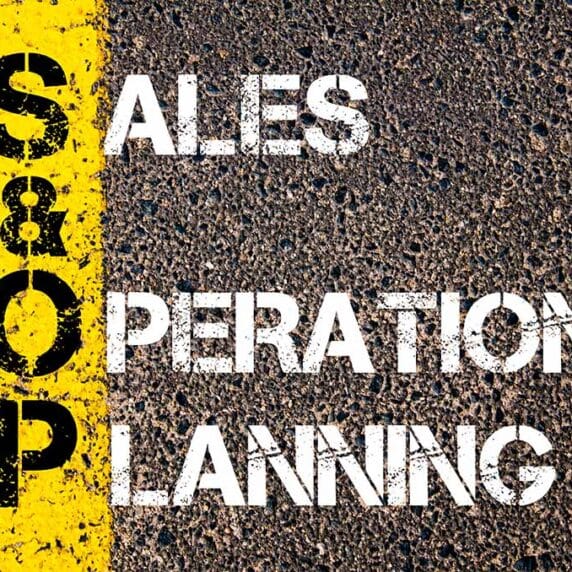Podcast: Reinforcing Supply Chains Through Digital Transformation
In episode five of Be Ready for Anything, hear from George Fowler, Group Vice President at Spinnaker SCS, about how strategic digital transformation initiatives prepare supply chains to successfully withstand significant business disruptions.
Check out the video below.
Or listen and follow on Spotify.
Transcript
Katie Van Adzin: Hi everyone, and welcome back to the Be Ready for Anything podcast with ToolsGroup! I’m your host, Katie Van Adzin, and today I’ll be talking with George Fowler, group vice president of Spinnaker’s supply chain planning systems implementation and managed services practice. George has over two decades’ worth of experience in supply chain and management consulting and has collaborated many times with ToolsGroup on industry research. Thanks for talking to me today, George. How’s it going?
George Fowler: Going well, Katie, it’s a pleasure to be here. How are you doing today?
Katie Van Adzin: I’m doing well. So, you’ve done a lot of research into the importance of companys’ preparedness in terms of digital transformation. How have you seen that affect organizations’ outcomes in relation to the COVID downturn?
George Fowler: That’s a great question Katie. You know it’s interesting, digital transformation in supply chain planning is a lot like wearing a mask in the middle of COVID. It’s a little late after you’ve been infected to put on your mask. This is something that you need to do in advance. So as you look at companies, there are a lot of companies where they’re doing well despite themselves today. Companies who are medical providers, athletic equipment providers, wine and spirits providers are companies that are gonna do well in this type of environment despite themselves, but the rest of the companies that are out there really need to determine how to deal with lost sales in a volatile environment, they’re dealing with the shift in their portfolio and seeing a true increase or decrease in their demand based upon the availability of customers that are coming into their stores or able to buy with them.
So one of the things that we’ve seen is how a company conducts itself based upon understanding data around the outbreaks, understanding how it’s going to model things like how is it going to get its raw materials? How is it going to deal with a short supply and disruptions associated with bringing in their products and selling them in different venues?
What I found most interesting as I did a lot of research and this research has grown since the pandemic has started is that there was some research done by the Insurance Institute where they looked at about 1,800 companies. And what they found was that most companies, regardless of where they’re located and so on, they actually go through types of downturns like this on a regular basis. So as an example there’re catastrophic business interruptions or disruptions that might occur from fire, cybersecurity breaches, weather and these things happen every three to four months for most companies.
So those companies that haven’t taken on the mantle and determined that they need to invest in a digital transformation platform are lagging behind. And in many cases they are suffering. They’re suffering from indecision and difficulty in making key decisions on how they’re gonna move their businesses forward. And they’re also struggling from the perspective of building strategies that will help them be more resilient when things happen. Put more succinctly, if a company hasn’t done its due diligence around building a digital transformation strategy by now, in some cases for some of these companies it may be too late, but the call to action is here.
Katie Van Adzin: Yeah, for sure. And when it comes to corporate planning tools, what would you say are the make-or-break capabilities that companies should be looking for?
George Fowler: Yeah that’s another interesting question because over the recent months a lot of due diligence has been paid into looking at a company’s previous history and looking at what has driven their supply teams in the past or what has driven the demand for their products in the past. And a lot of those capabilities are no longer present. So unfortunately, there is a need to sort of re-look at the core capabilities that are part of a supply chain and making sure that they can handle the challenges associated with a lack of true statistical forecast accuracy because you didn’t have that history to rely on or disruptions in procurement strategies that require you to change your network on the fly and also dealing with challenges of getting your products to the store or directly to the customer.
So there are some key features that we found that are helping customers who are doing a lot of work around digital transformation. And those are those companies that have a digital twin. They are really excelling now because they’re able to reduce the time to decision. They’re able to make very quick, concise decisions in a forum that they trust the data quality. Environments where you have collaboration. So being able to collaborate with your vendors. So if they have a disruption upstream and you can’t get raw materials and you know that you need to move on to the next vendor. Companies are doing a lot of product segmentation now. So that analysis was often left to kind of the wayside, in many cases companies that were using advanced planning systems treated all of their products the same. Today they have to understand that what drives demand may be a scarcity of supply. So everything is selling or on the other hand, there are only certain products that sell.
So being able to do some sort of product segmentation within your tool the way that ToolsGroup does is an invaluable capability via any platform today. And then doing some network planning, because as we know, there are disruptions all over the place. I’ve dealt with a lot of companies like food companies who have had disruptions in their plants or pharmaceuticals companies who couldn’t get the inputs or the raw materials that they needed to make their products. That happens a lot these days. Industries like agriculture, where you’re getting a lot of your raw materials from overseas, the ability to, within your tool, measure and move your sourcing from place to place depending on what kinds of interruptions and disruptions you have are critically important.
And then there are the advanced features that we’ve found that are quite helpful. Some of those being machine learning. So the fact that you can bring in nontraditional data types and figure out correlations between the forecast that you did have and the impact of those things that you want to measure. So using a probabilistic forecast, you can say what’s the likelihood of a sale of a certain type of product in a given area given causal factors like COVID outbreaks. So those are key features. There are industries out there that we found that are doing these things very well and have used their digital transformation platforms, as well as these capabilities to actually drive innovations in how they get to their customers. As an example, in the food industry, I don’t know if you’re a social media junkie like I am, but I get these Facebook ads for food like lobster and all kinds of food and I’m a seafood lover, delivered directly to me. And so bypassing the store where I would traditionally buy this type of food, I can get shipments of lobster or crab or something like that shipped to my house. And this is an example of companies who are innovating around the digital transformation that they’ve done. Understanding their customer base and then using that to actually change their sourcing networks and get it directly to the customer, who’s me. So they knew I was the ultimate source of demand. They’re just bypassing the store that I can’t get to.
Katie Van Adzin: Yeah. That’s a really interesting development. Going back for a second to what you said about resilience, we’ve all seen over the last six months, the consequences of supply chains that were not prepared. What are your suggestions for companies that want to make sure their supply chains become more resilient?
George Fowler: A good point. Well there are probably five things that I would suggest for these companies. The first thing in terms of getting a digital transformation strategy is having the right planning tools and capabilities. Really investing in those today and making sure that they are up to speed. In many cases we work with a lot of companies that have implemented solutions 20 years ago, and haven’t changed the way that they utilize it and so on because it’s easy and everyone understands it. But if it doesn’t truly represent your business today, then you’re doing yourself a disservice when a disruption like this occurs. So again, having the right planning tools and capabilities.
Secondly, implementing a resilient network. As I mentioned from the last question, having the ability to pivot when there’s a supply disruption and not always going after the cheapest mode of transportation but de-risking the supply chain by making sure that you have alternative sources of supply. There’s a saying that we’ve been using a lot lately and that’s get your “ASS in gear,” your alternative sources of supply. So a lot of companies have been doing that quite well and understanding that if you’re trying to get specific inputs from companies across the pond or overseas, it may be a good time to look at more local companies and so on that can facilitate the same needs.
Other areas are just monitoring and adjusting your critical business KPIs. As I mentioned before there are companies that have been running with the same operating parameters and the same KPIs for many years. This is the time to dig in and really understand what they mean and start to adjust those accordingly. I see a lot of this happening as part of S&OP planning solutions, a lot of the collaborative planning capabilities that ToolsGroup, SO99+ and Board have together give companies the ability to continue to integrate and monitor these activities but do it holistically across the business.
I would also I think it’s not always technology. Sometimes it’s implementing a knowledge retention and change management program. The people are important and especially when people are dispersed or people might become ill and so on. So unfortunately in this day and age we’ve realized how important the people are to your supply team. So not only do you want to establish the policies and procedures and so on but you want to record those. If you’re in a company where you’ve implemented a solution and you’ve developed the guidelines and you just let the system run up on its own without kind of recording those for historical and archival purposes in some sort of documented form so that people understand it, you’re at risk because those people can disappear. And unfortunately when they do, they take the knowledge of how to run your supply chain with them. And so it’s important to retain that and focus on that as a part of your digital strategy.
I think the last piece here is really implementing an effective scenario planning strategy. Again, whether it’s part of S&OP planning where you’re dealing with differentiated demand scenarios or implementing something that does demand/supply balancing based upon different scenarios, it’s important to do that as I mentioned. Doing different network planning scenarios as well. So, understanding that if there is a supply interruption here, what are we going to do? A big example of that is what happened in the food industry, where they had a backlog of plants that couldn’t get the animals there to slaughter. And so there was a backlog of those and because the machinery can’t handle the specific animals after a certain size, they actually had to dispose of them. And that’s unfortunate because it’s a waste of food and farmers’ livelihoods there. From that perspective doing a fair amount of network planning and alternative network planning, and again doing the alternative sources of supply are important. And then modeling your allocation strategies as well.
So that’s just as important as it is to figure out how you’re going to get your raw materials in. It’s important to figure out where you’re gonna send your products to on the way out. One of the things that we found is like in the medical industry, sometimes you’re dealing with not the most profitable area or the highest demand. Sometimes you’re dealing with getting products to the highest need from an outbreak perspective. Or if there’s a weather change and so on a lot of companies are doing control towers and so on that are helping them to figure out where to send their products, how to avoid disruptions within their network and also model what is the least risk deployment strategy for their products. And then of course there also is following the demand. So making sure that you get the product to where your customers are.
Katie Van Adzin: I wanted to touch a little more on what you were saying about KPIs. So if a company is trying to take stock of its preparedness in terms of disruption and digital transformation, what kind of metrics should they be looking at and where would you suggest that they go to find this data?
George Fowler: It’s funny, I’ve been in supply chain a little over 25 years, and I’m kinda one of the old school guys that are like the fundamentalists who will always believe that supply chain planning always started with a good forecast. And I will admit, going through this type of a catastrophic event where you have a global pandemic, it’s kind of turned that philosophy on its head. Forecasts are unreliable. The data that you’ve used for many, many years to drive that statistical forecast is unreliable now. And so while companies have traditionally looked at their demand as a driver, quite frankly what I’ve seen today is that KPIs and drivers around supply chain interruptions have fallen aside and companies are focusing more on inventory-related KPIs.
So as an example, things like form and fit of inventory. Do I have the right inventory in place? Is it at the right echelon within my network? Do I have enough of that? And do I have what people truly need? As I do product segmentation, am I actually figuring out the right mix of products? So a lot of analytics and KPIs that are driven off of determining whether I have the right inventory at the right place is really being focused on. I also see a lot of the traditional metrics around inventory and distribution planning, the days of coverage, the safety stock, the fill rates and so on are being reviewed. And in many cases additional buffers are being added to make sure that they have sufficient inventory to cover manufacturing requirements or longer lead times for products and so on.
So those types of things are definitely a part of what companies are doing, but I think more importantly—and this is a huge change that I’ve seen in recent months—and this is around cost of goods sold. So cost has become a major driver. In many cases the costs of our materials are growing and getting higher because products are harder to get or the particular allocation that we might get from a supplier may not be as high. So in many cases, companies are looking at their cost of goods sold through a different lens where they’re looking at forward buy opportunities. Well if I buy an extra 20% can I get a price break on that? So that’s taking into account costs, it’s taking into account my inventory projections, it’s taking into account my projected demand, and whether I’ll be able to sell those products. We’re also seeing a lot of make-versus-buy decisions. So in some cases like in the chemical industry, I’ve been working with some companies there that are actually saying, “You know what, it might be cheaper for us to change and actually start to make these products on our own and then use the byproducts and so on to make other things downstream as a means to deal with the current situation.” But the KPIs that tell them that they can do that are ones that they’re monitoring.
Katie Van Adzin: So my final question for you today is around scenario planning. You touched on how important effective scenario planning is, now more than ever. What would you advise companies to look at to make sure that their scenario planning is truly effective?
George Fowler: Well in order to make scenario planning effective I think there are three things you need to do. The first thing is automation. As part of any digital transformation strategy, automating the input of data from whatever systems you’re using. In many cases we’re seeing companies invest in digital twins or some sort of operational data store. It is critical. It’s more critical than ever to have that data readily available because speed to decision is critical now. If it takes you months to pull together information from different spreadsheets, then rationalize it between whose definition of what a product is or what a cost is or any other of the the various supply chain information that would be bringing in, if it takes you too much time to do that, you’ll miss the window of opportunity.
And in many cases, that’s what we’re seeing. Not that customers don’t have a handle on what they want to find, it’s just that it’s taking them too long to get to the information and making that decision. Just as importantly, data quality. It’s important that when you’re bringing that data in from your digital twin or from your operational data store, you can rely on that data. So making sure that there is a data quality management project or process in place to ensure the quality of that data that you’re making the decision on. Because these decisions today are being done at the speed of light and you want to be able to rely on its accuracy.
I think the last point is to plan for the rainy day scenario. So we’ve talked a little bit about some of the scenarios there, and I’ve talked to some companies who are used to dealing with scenarios that are very rounded. And what I mean by that is everything is four quarters, it’s 18 months, it’s in numbers that are rounded and so on. And in some cases you’ve got to deal with some jagged edges, so to speak, where you are planning for eight months of a downturn or you’re planning for a supply interruption of several years at this point because you can no longer get product to a certain place. And so dealing with realistic scenarios that take into account the potential worst case scenarios, and then using that, and again keeping in mind that these are scenarios, these are not real life events. So what you’re planning for is what will possibly happen so that you can build the governance and the decision tree that you’ll use when those events actually happen. So again, planning for the worst case actually gives you the ability to say, “Here are my policies and procedures and the course of action that I want people to take when either that happens or something less than that happens.” So it gives the people the degrees of freedom to make decisions based upon.
Katie Van Adzin: That’s great. Well thank you again George, for sharing all of this knowledge with our audience and I look forward to talking to you again sometime soon.
George Fowler: Katie, it was a pleasure. Thank you for your time.






